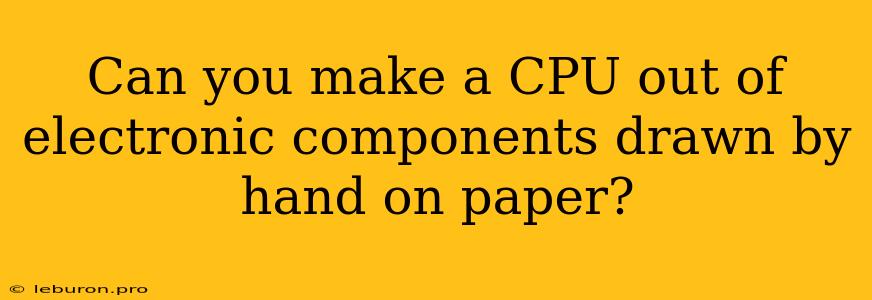The question of whether one can build a functional CPU entirely from hand-drawn electronic components on paper is a fascinating one that delves into the very nature of electronics and the limits of our understanding. While the concept seems whimsical and perhaps even impossible, the answer lies somewhere in the complex interplay of materials science, electrical engineering, and the ever-evolving landscape of technology.
The Fundamental Challenge: From Concept to Reality
The core issue lies in the nature of electronic components and their interaction with electricity. A CPU, at its heart, is a complex network of transistors, capacitors, and resistors that process information through the flow of electrons. These components are typically manufactured using intricate processes involving semiconductor materials, precise etching techniques, and highly controlled environments.
Hand-drawn components on paper, by their very nature, lack the required precision and conductivity to form the intricate circuitry needed for a functional CPU.
The Limitation of Paper: Material Science Matters
Paper, a porous and organic material, is inherently unsuitable for creating the conductive pathways and precise structures required for electronic components. The conductivity of paper is extremely low, making it highly inefficient for carrying electrical signals. Additionally, the surface of paper is not smooth enough to allow for the creation of the fine lines and intricate geometries necessary for transistors and other components.
The Struggle for Precision: The Importance of Fabrication Techniques
Even if we could overcome the material limitations of paper, replicating the precision of modern semiconductor fabrication techniques using hand-drawn components would be an insurmountable task. Modern CPU fabrication involves etching transistors with features measured in nanometers, a level of precision impossible to achieve with hand-drawn methods.
Exploring Alternative Approaches: Pushing the Boundaries
While directly drawing a functional CPU on paper is highly improbable, exploring alternative approaches can illuminate the potential of unconventional electronics.
1. Conductive Inks and Printed Electronics: A Glimpse of the Future
Conductive inks, such as silver nanoparticle inks, offer a glimmer of hope. These inks can be printed onto various surfaces, including paper, to create conductive pathways. This opens up possibilities for creating simple electronic circuits, but the complexity required for a CPU remains a significant challenge.
2. Graphene and Nanomaterials: The Promise of New Materials
The emergence of materials like graphene, with its exceptional conductivity and flexibility, might open new doors. Researchers are actively investigating the potential of using graphene to create thin-film transistors and other components that could potentially be printed on paper.
Beyond Functionality: The Importance of the Concept
While building a fully functional CPU on paper might be beyond our current capabilities, the pursuit of this concept serves as a catalyst for innovation. It forces us to rethink the fundamental limitations of electronics and explore new materials, fabrication methods, and design principles.
The Future of Electronics: Exploring Unconventional Solutions
The quest to push the boundaries of electronics necessitates exploring unconventional approaches. From the development of new materials like graphene to the exploration of organic electronics, the future of technology lies in finding solutions that transcend traditional limitations. The concept of hand-drawing a CPU on paper, while seemingly impossible, serves as a valuable reminder that limitations are often self-imposed and that true innovation often arises from daring to challenge the status quo.
Conclusion
The idea of creating a CPU from hand-drawn electronic components on paper is a compelling thought experiment that highlights the limitations of current materials and fabrication techniques. While directly drawing a CPU on paper is unlikely, exploring alternative approaches, such as conductive inks, graphene, and other emerging technologies, could pave the way for the development of new electronic devices with unique capabilities and applications. The pursuit of this seemingly impossible goal serves as a valuable reminder that innovation thrives on pushing the boundaries of our understanding and venturing beyond the limitations of established norms.
